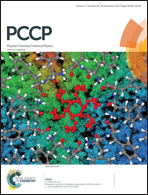Suspensions of carbon nanofibers in organic medium: rheo-electrical properties†
Abstract
The nonaqueous suspensions of carbon nanofibers (CNFs) in 1 M lithium bis(trifluoromethanesulfonaimide) in propylene carbonate electrolyte reveal unique structural evolution and shear-induced transition due to the high aspect ratio. The rheo-electrical behavior elucidates a microstructural transition from entangled-to-aggregated networks above a distinct percolation threshold. Under shear flow, both networks show a three-regime flow curve and an inverted-bell-like conductivity curve as a consequence of shear-induced alignment (entangled network) and shear-induced breaking up (aggregated network). The different particle morphology of carbon nanofibers (anisometric) and carbon black (CB; isometric) causes different aggregation mechanisms (aggregate vs. particulate) and then varied microstructure for their suspensions in the same electrolyte. This fact explains the higher rigidity and lower electric conductivity of CNFs than CB suspensions. Interestingly, the suspension of hybrid carbons at the optimum mixing ratio merges the advantages of both carbons to operate efficiently as precursors in the formulation of electrodes for energy storage systems.



 Please wait while we load your content...
Please wait while we load your content...